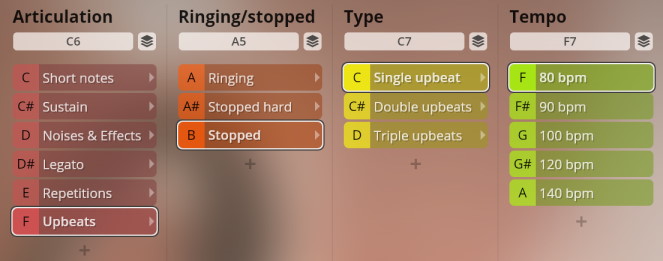previously "SYNCHRON-ized Plucked Instruments"

Studio Upright Bass was specifically created to enrich the tonal palette of your Synchron Instruments with sounds that complement the scope of the symphonic orchestra very well. The upright bass was recorded in the relatively dry and controlled environment of our second studio, the Silent Stage.
Studio Upright Bass provides two different kinds of Presets, accessible by clicking on the icons “Flow” resp. “Precision” in the Synchron Player’s top bar. Flow Presets offer an intuitive, graphic approach to the library’s contents, with instrument, articulation, and sound parameters displayed in a single window.
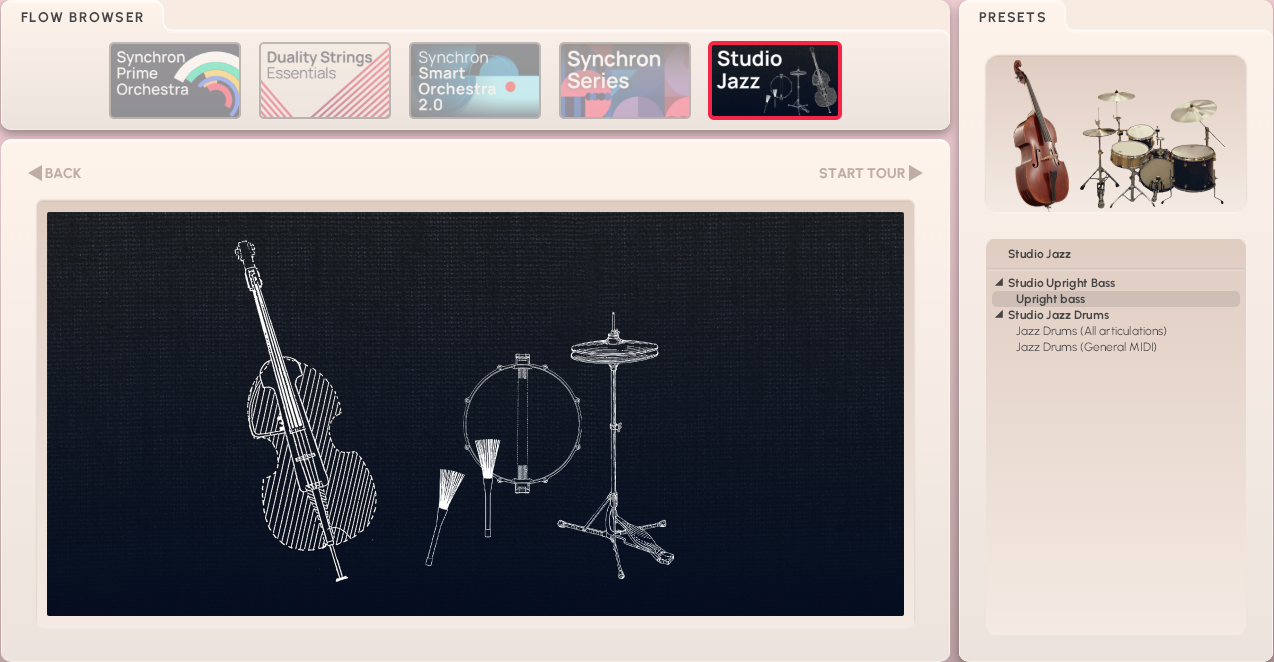
Precision Presets are what you already know if you own other VSL libraries. They allow you to explore the depths of the library, adjusting and tweaking parameters as you see fit. Here you can also create presets of your own and tailor them to your workflow.
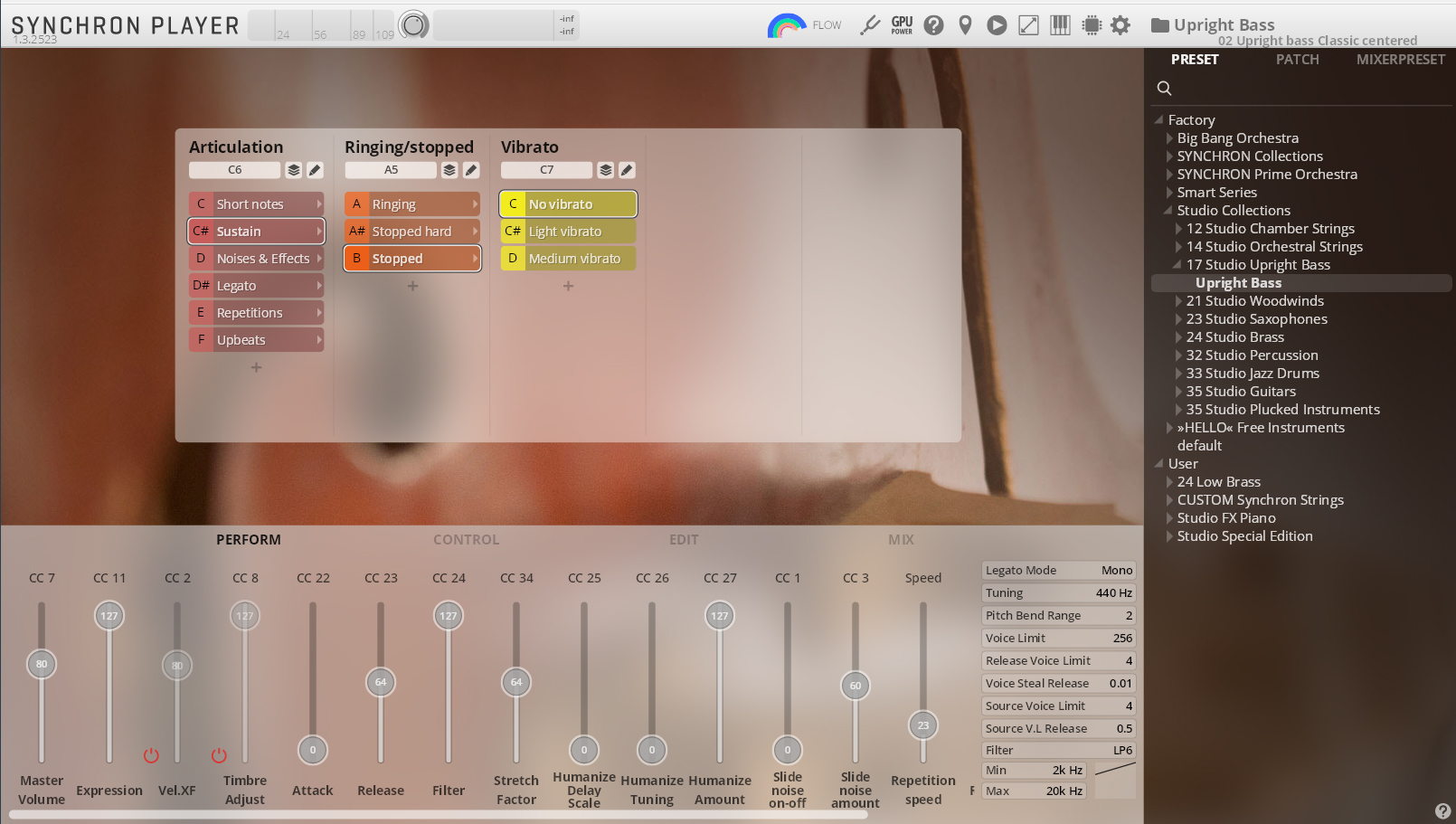
The Flow Preset gives you instant access to the most important parameters of an instrument, its articulations, and general sound settings in the Synchron Player’s Flow view. The display is subdivided accordingly, with the graphic keyboard underneath. On the Flow Browser page, you can click on “Start Tour” to step through explanations of the different Flow elements and parameters. Alteratively, you can click on the Info Hub icon in the instrument pane as shown below, where you can start the tour or connect to our online instrument academy.
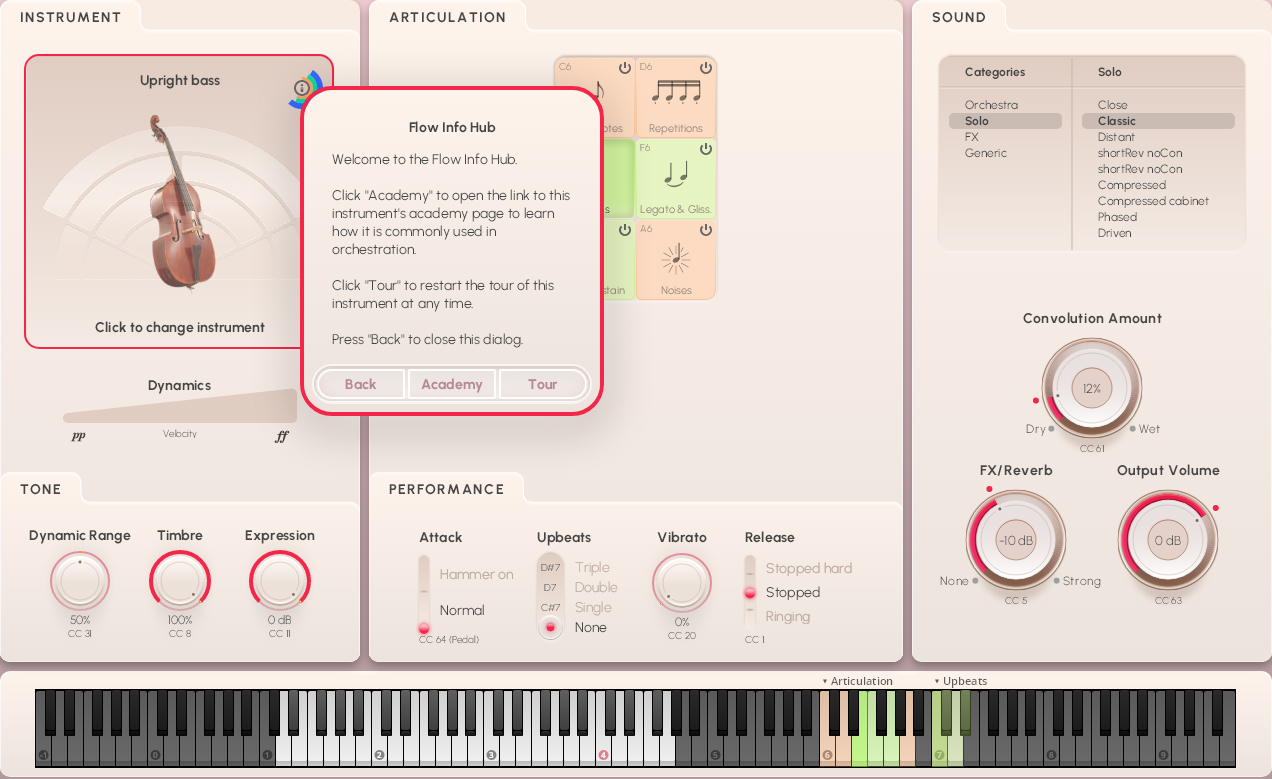
The Instrument section shows a symbolic image of the selected instrument headed by the name of the loaded Preset. You can return to the Flow Browser to select another instrument by clicking on the field. Clicking on the Info circle will connect you to the Vienna Academy, our instrumentology site.
For the bass, the Dynamics fader under the instrument is by default set to keystroke velocity. The only exception are the arco sustains, which are controlled by the modwheel (MIDI CC1), so that you can influence the volume of a note being played by changing the controller value. You could also set this to a breath controller (MIDI CC2), leaving your hand free for other stuff.
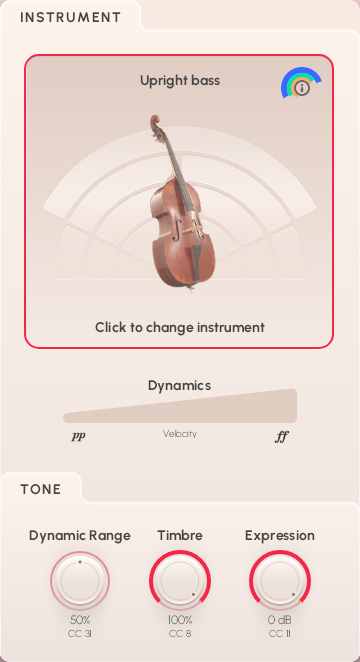
In the Tone field, you get access to three other items which may be an important factor in making your piece sound truly alive:
Dynamic Range (MIDI CC31) lets you determine the sensitivity to keystroke velocity, which can thus be narrowed or expanded.
Timbre (MIDI CC8) affects the tone of the instrument, making it sound brighter or darker.
Expression (MIDI CC11) is an additional volume control defining a percentage of CC7 (volume), and can be used for automation.
The Articulation pane holds all the samples, so to speak. In the upper field, you see the possible choices with their keyswitches, which are also marked on the Synchron Player’s virtual keyboard. Of course, you can also click on a button to switch to that articulaton. The articulation buttons are color-coded: orange for short notes, and green for long ones.
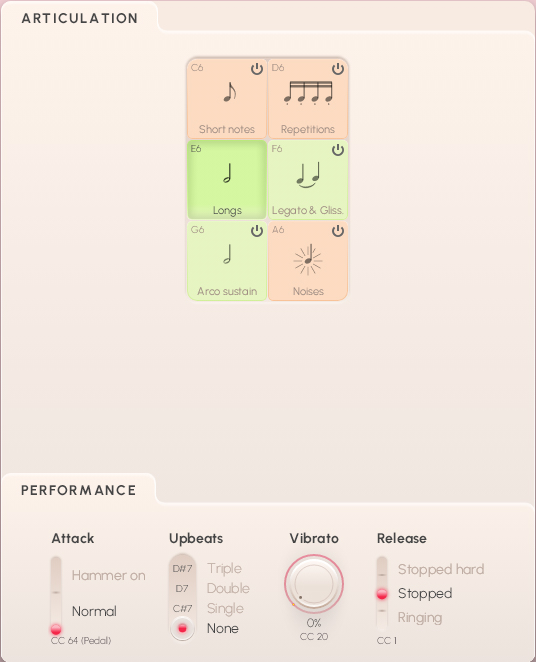
The Performance field contains all the playing variants of the selected articulation. So, depending on the number and type of variants, the performance options may look quite simple. There are up to four different parameters per articulation. Here’s a few examples:
Short and longs notes allow you to choose their Attack (MIDI CC64, the pedal): the short notes have regular and snap attack, the long notes can be switchet between normal and hammer-on.
Upbeats for long notes can be selected via keyswitches from C7 to D#7. If upbeats are selected, the vibrato fader changes to a Tempo selector with keyswitches from F7 to A7.
Long notes, legato, and repetitions feature a Vibrato fader knob assigned to MIDI CC20, allowing you to “soft-switch” with a narrow crossfade area between samples without and with vibrato.
Release offers different release options with the help of MIDI CC1 (modwheel) for all except arco and noises, so that you can switch between ringing, stopped, and hard-stopped release variants.
In the Sound pane, you can select a basic Category on the top left, and one of the Mixer Presets from that category on the right.
Convolution Amount (MIDI CC61) adjusts the dry/wet balance and is only available when a mixer preset using convolution is loaded.
FX/Reverb (MIDI CC5) sets the amount of reverb, which is different in intensity according to the selected preset.
Output Volume (MIDI CC63) takes care of how much of what you do comes out of the Synchron Player.
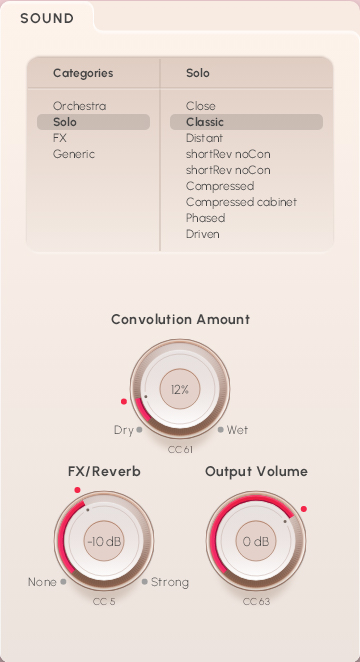
The instrument Presets comprise all recorded Patches in Articulation groups, which again contain Types of the respective Articulation, with further options if available. The general structure was modeled after our other Synchron Collections, making it easy to switch or combine instruments without major adaptations.
Articulations are enabled by default. Disabling a slot means that all the slots dependent on it will be deactivated, too, so if you happen to be short of RAM it is possible to deactivate anything you don't really need (you can always add more stuff later).
By default the mapping of keyswitches for Articulations starts at C1 (for Middle C = C4) for higher instruments – in this case, concert and overdrive guitar –, and C6 for bass instruments – here, the upright bass. Other slot categories, e.g., release type, vibrato, etc., use keyswitches or dimension controllers such as the modwheel or playing speed.
Articulation groups: short notes, sustain, noises & effects, legato, repetitions, upbeats
Range: D1–G4 except where indicated otherwise.
Staccato, portato short and long, damped, and muted.
- Type keyswitch: C7–F7
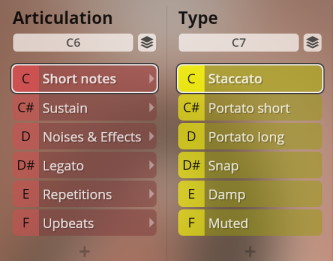
Sustained notes ringing, stopped hard and normal, without as well as with light and medium vibrato.
- Keyswitches
- Ringing/stopped: A5–B5
- Vibrato: C7–D7
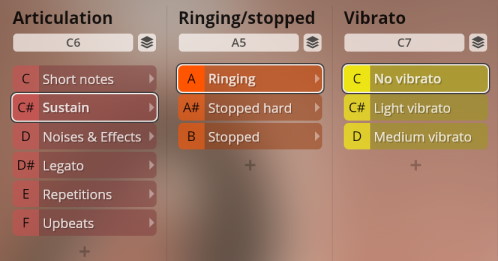
Slides up and down, legato slides, finger stop, body noises, and sustained notes played with a bow.
- Type keyswitch: C7–F7
- Range
- slides up/down C2–F4
- finger stop D#1–G4
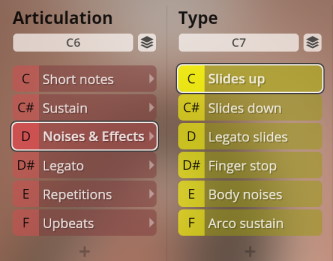
Slides up/down mapping
- C2–A#2: fast slides 1–8
- C3–A#3: medium slides 1–8
- C4–F4: slow slides 1–4

Body noises mapping
- C, D: single hits, l/r
- C#, D#: fast repetitions, var. 1/2
- F, G: performance repetitions, medium, var. 1/2
- F#, G#: performance repetitions, slow, var. 1/2
- C1–G#1: body hits, finger
- C2–G#2: body hits, knuckle
- C3–G#3: rib hits
- C4–G#4: fingerboard hits
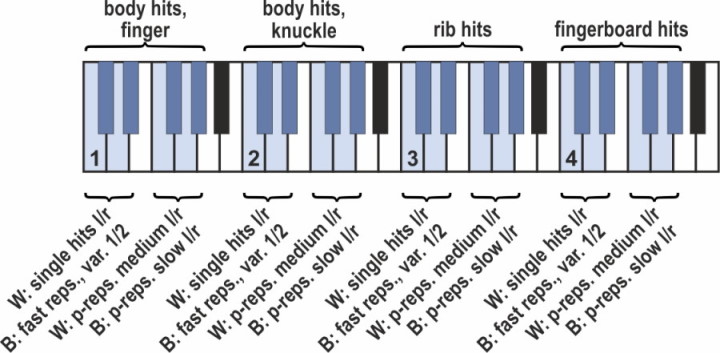
Legato, ghost notes, glissando, and slow glissando, ringing, stopped hard and normal, without and with slide noise.
Keyswitches
- Ringing/stopped: A5–B5
- Type: C7–D#7
Slide noise switch: Dim.Ctrl/B (CC1, Modwheel)
No Slide
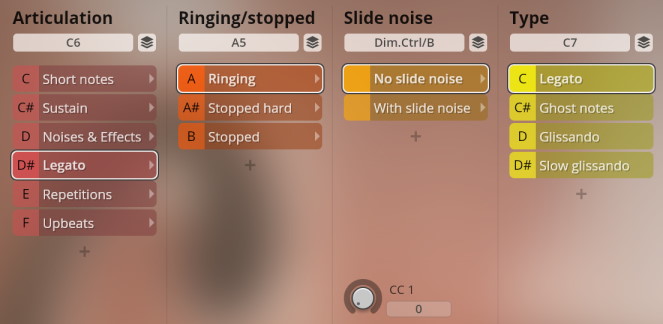
Slide
Use Dim.Ctrl/A (CC3) to adjust the noise amount of the slides.
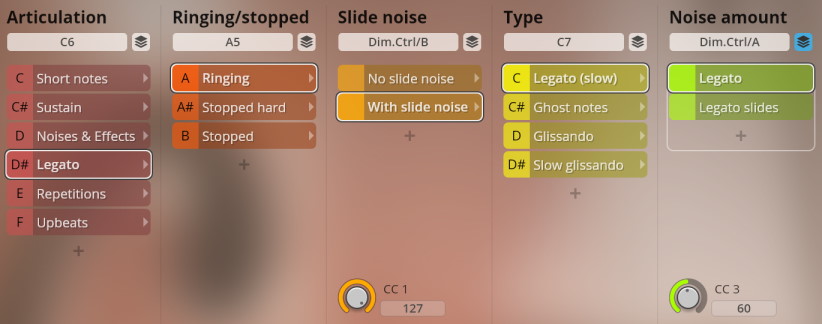
Repetitions ringing and stopped hard without and with vibrato, and stopped normal.
- Ringing/stopped keyswitch: A5–B5
Ringing, stopped hard
- Vibrato keyswitch: C7/C#7
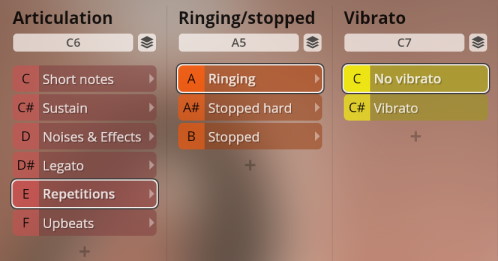
Stop normal
Slow without and with vibrato, portato slow and fast, and autospeed.
- Type keyswitch: C7–E7
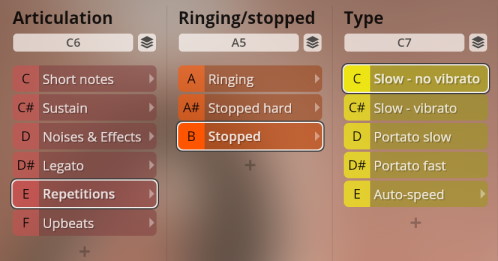
Autospeed
This slot uses Dim.Ctrl/D (playing speed) to switch automatically between slow notes without vibrato, slow portato, and fast portato.
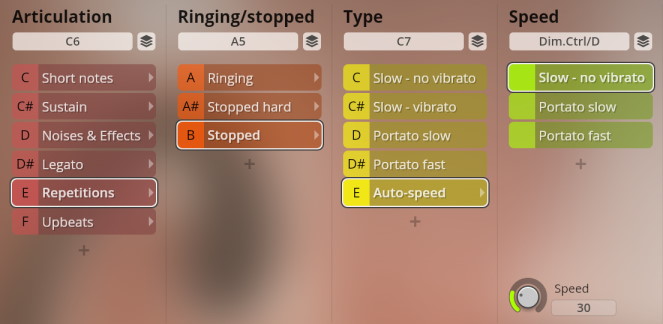
Single, double, and triple upbeats at 80/90/100/120/140 BPM.
- Keyswitches
- Ringing/stopped: A5–B5
- Type: C7–D7
- Tempo: F7–A7
